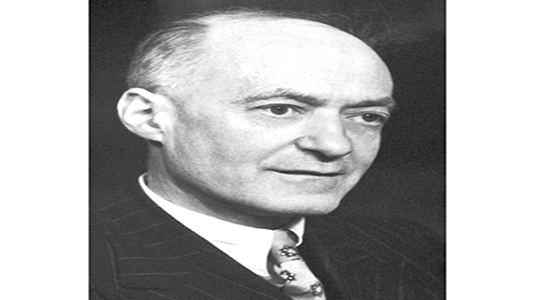Acknowledged as an authority on chemical kinetics and chain reactions and later on for his research on the kinetics of bacterial growth, the British physical chemist Sir Cyril Norman Hinshelwood was awarded the Chemistry Nobel Prize in 1956 jointly with Nikolay Semenov. The Soviet physicist was honoured for his independent research on the mechanism of chemical transformation.
Hinshelwood’s research on explosives and bacterial cell chemistry paved the way for research on antibiotics and other therapeutic agents. He was knighted in 1948 and received the Order of Merit in 1960.
Early years
Born in London on June 19, 1897, Cyril Norman Hinshelwood was the only child of Ethel Smith and Norman Macmillan Hinshelwood, a chartered accountant. His father passed away when he was just seven years old. Although many of his relatives were artistically inclined, he was the first in his family to pursue a career in science.
Hinshelwood was educated at Westminster City School and then at Balliol College of the University of Oxford from where he earned his Master of Arts and Doctor of Science degrees in 1920, completing both courses in just one year. Before studying at Oxford, he worked briefly from 1916-18 at a WWI explosives supply factory as a laboratory chemist. Here, his remarkable aptitude for scientific work was noticed and earned him the nickname of ‘boy wonder’. His work involving the slow decomposition of solid explosives by measuring the gas evolved sparked an interest in studying the mechanism of chemical change, a topic that became the main focus of all his research work later on.
From 1921-1937, Hinshelwood tutored at Trinity College, and in 1937 was appointed as Dr. Lee’s Professor of Chemistry at the University of Oxford.
As a tutor and professor, he was known for simplifying complex subject matters, motivating students to think and take an interest in understanding and studying different topics. He was also very appreciative of the students who engaged in research activities under his supervision and never failed to acknowledge the work they did. Many of his students went on to achieve success in the chemical industry, while others became academics in Britain and abroad.
Scientific achievements
Sir Cyril Hinshelwood commenced his research work at Oxford, measuring the rate of decomposition of solid mixtures under diverse conditions and then moved on to studying gaseous reactions. In 1926, he published the classic text Kinetics of Chemical Change of which several editions were printed. A year later, he started the work for which he is most recognised. He began researching the kinetics of the chemical reaction between the two basic natural elements—hydrogen and oxygen—and showed that the formation of water from the combination of these two is a chain reaction. (While investigating the kinetics of chemical transformation, Nikolay studied the reaction between phosphorus and oxygen.)
Hinshelwood showed that chain reactions can be branched and radicals play a key role in these kinds of reactions, and also that his theories on chain reactions tallied with observations of the reaction between oxygen and hydrogen. Another aspect he confirmed was that surfaces are an important factor in many chemical reactions. He also found that certain chemical processes are controlled by the volume, others by the surface of the vessel in which the reaction takes place. Hinshelwood’s work had practical implications for everyday life. For instance, his study of reaction mechanisms facilitated the synthesis of common household synthetic polymers.
By the late 1930s, Hinshelwood turned his attention to biology. He believed that the behaviour of simple organisms like bacteria could be explained through the laws of physics. He therefore carried out a number of experiments on the growth and adaptation of bacterial cells. His work made it possible to study the nature and role of vitamins and bacterial resistance to antibiotics. He published over 130 papers on his work on bacterial growth. His book Chemical Kinetics of the Bacterial Cell was published in 1946.
Convinced of the importance of RNAs in the synthesis of proteins and DNA as a controller of cell division, he studied the distinct behaviour of these two nucleic macromolecules under different growth conditions. Hinshelwood is acknowledged to have been the first to propose through an article published in 1950 that the nucleic acid determines the sequence of amino acids in the synthesis of proteins. What he had proposed brought him very close to understanding the nature of DNA whose structure was discovered three years later by Jim Watson and Francis Crick. Though not much attention was given to Hinshelwood’s proposal then, his contribution towards understanding how DNA might work was acknowledged by Crick in 1966.
Philosopher-scientist, linguist, and polymath
Sir Cyril Hinshelwood was acclaimed not just as a pioneering physical chemist but also as a scholar whose knowledge and interests extended beyond the realm of science. He was knowledgeable about literature and poetry and topics ranging from Beethoven’s music to Chinese pottery and Persian carpets. His vibrant classical and philosophical background shone through in his talks which invariably revealed deep insights into the philosophical implications of his subject.
He considered scientific research to be a creative activity and science as one of the most humane studies. In his talks, he deplored the fact that philosophical aspects were often ignored in science and that there was an unhealthy indifference to the relationship of science to existence in general. He often focused on the ‘internal and external world’, stressing that moral qualities cannot be explained by natural selection, human behaviour is not machine-like, human consciousness should not be underestimated, and that the mind-matter relation cannot be ignored in an intelligent consideration of existence. He believed that art and science have similar roots and that “The paths of art and poetry, science and religion are the means by which man grasps the universe, surrenders himself to it, identifies himself with it, loses himself in it…”
Even audiences outside the scientific fields whom he was often invited to address on the mystery and wonder of Nature, used to be captivated by his eloquence, clarity of thought, and vast knowledge.
It is believed that Hinshelwood learnt a new language during every long vacation he took. He was well-versed in several modern and classical languages and even studied Chinese and Arabic. He compared the learning of a language to “the exploration of a new land, the savouring of a new form of art”.
Awards and recognition
Hinshelwood received numerous civil, scientific, and academic honours that included prizes, medals, and honorary degrees and fellowships. He was offered honorary memberships of renowned scientific societies in many countries. Besides the Royal Society, he served as the President of the Chemical Society, the Faraday Society, and also the Classical Association that promotes the study of the languages, literature, and civilisation of ancient Greece and Rome.
Hinshelwood remained a bachelor all his life and was devoted to his widowed mother with whom he often spent time in their London flat till she died in 1959. Often, when she visited him at Oxford during the vacations, they would travel together abroad.
On retiring from his Chair at Oxford in 1964, he moved back to his family apartment in London. He was alone at home when he passed away on 9 October 1967, just eight years after his mother. A few years after his demise, his Nobel Prize medal was sold as part of his estate. The medal was bought by an anonymous coin dealer in the 1970s and was put up for auction at Julien’s Auctions in California in November, 2017.
On that occasion, the founder of the auction house, Darren Julien, said, “We are honoured and delighted to be able to offer this historic medal which commemorates some outstanding scientific work by one of the greatest minds in his field of chemistry. It highlights how one avenue of science—explosives—can lead to advances in another, medicine.”
References
1. Nobelprize.org: Sir Cyril Hinshelwood–Biographical–Nobel Media AB 2019, https://www.nobelprize.org/prizes/chemistry/1956/hinshelwood/biographical/
2. Sir Harold Thompson: Cyril Norman Hinshelwood– Biographical Memoirs of Fellows of the Royal Society, Volume 19 (375-431)
3. Emma Stoye: Hinshelwood’s 1956 chemistry Nobel prize medal to be auctioned – Chemistry World, 3 November 2017, https://www.chemistryworld.com/news/hinshelwoods-1956-chemistry-nobel-prize-medal-to-be-auctioned /3008228.article
4. ArtDaily.org: Nobel Prize medal awarded to British scientist in 1956 for sale at Julien’s Auctions – http://artdaily.com/news/99919/Nobel-Prize-medal-awarded-to-British-scientist-in-1956-for-sale-at-Julien-s-Auctions#.XQfYH7wzY2w
5. Michel Morange: Cyril Norman Hinshelwood (1897–1967) – A chemical dynamic vision of the organic world – Journal of Biosciences 33 (5) December 2008, https://www.ias.ac.in/article/fulltext/jbsc/033/05/0669-0672
6. John Daintith, Sarah Mitchell: Hinshelwood, Sir Cyril Norman – Biographical Encyclopaedia of Scientists, Volume 1 (419-420)
7. World Heritage Encyclopaedia: Cyril Norman Hinshelwood –http://www.worldheritage.org/articles/eng/Cyril_Norman_Hinshelwood
8. Elizabeth H. Oakes: Hinshelwood, Cyril – Encyclopaedia of World Scientists, pp 336.
































